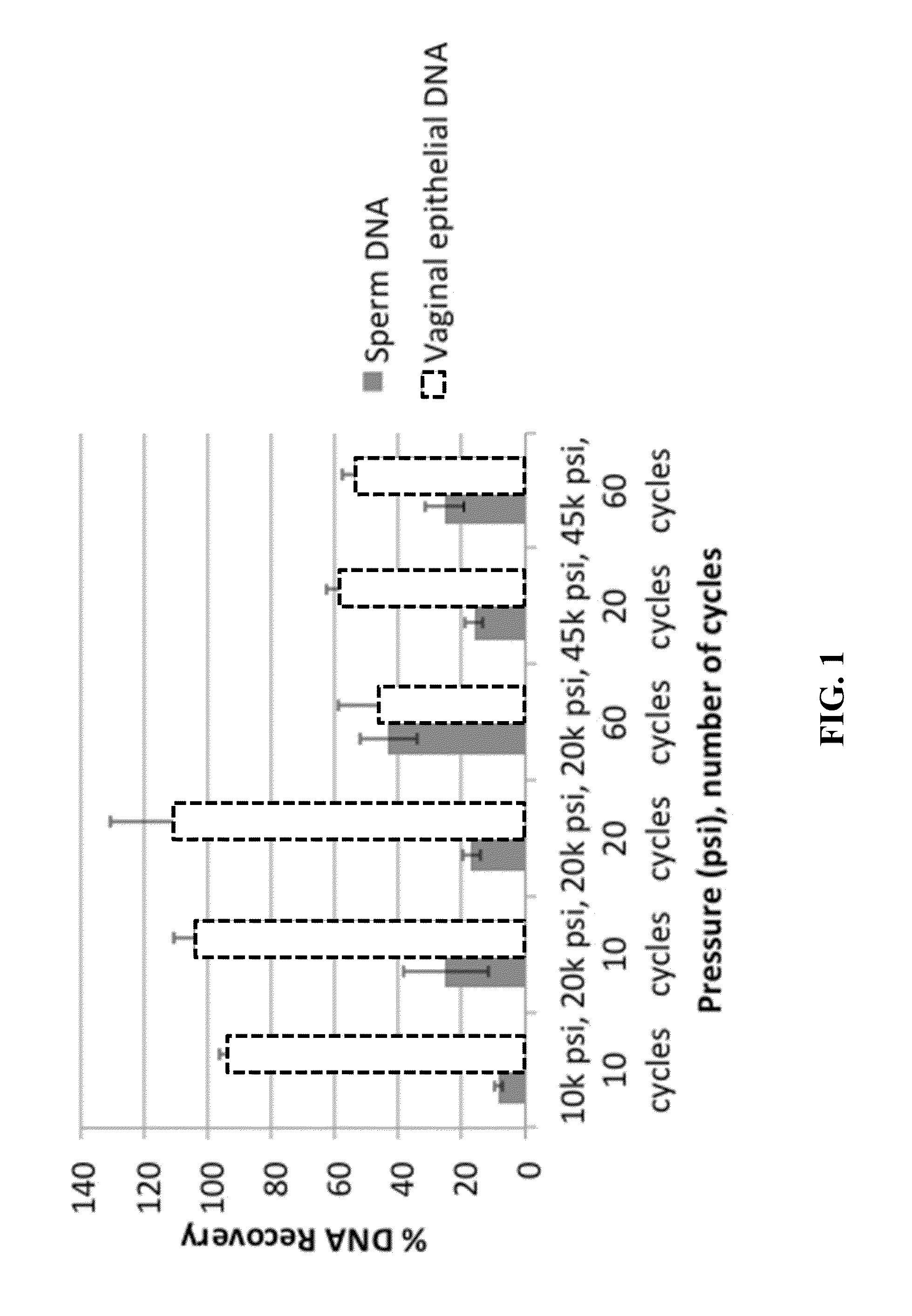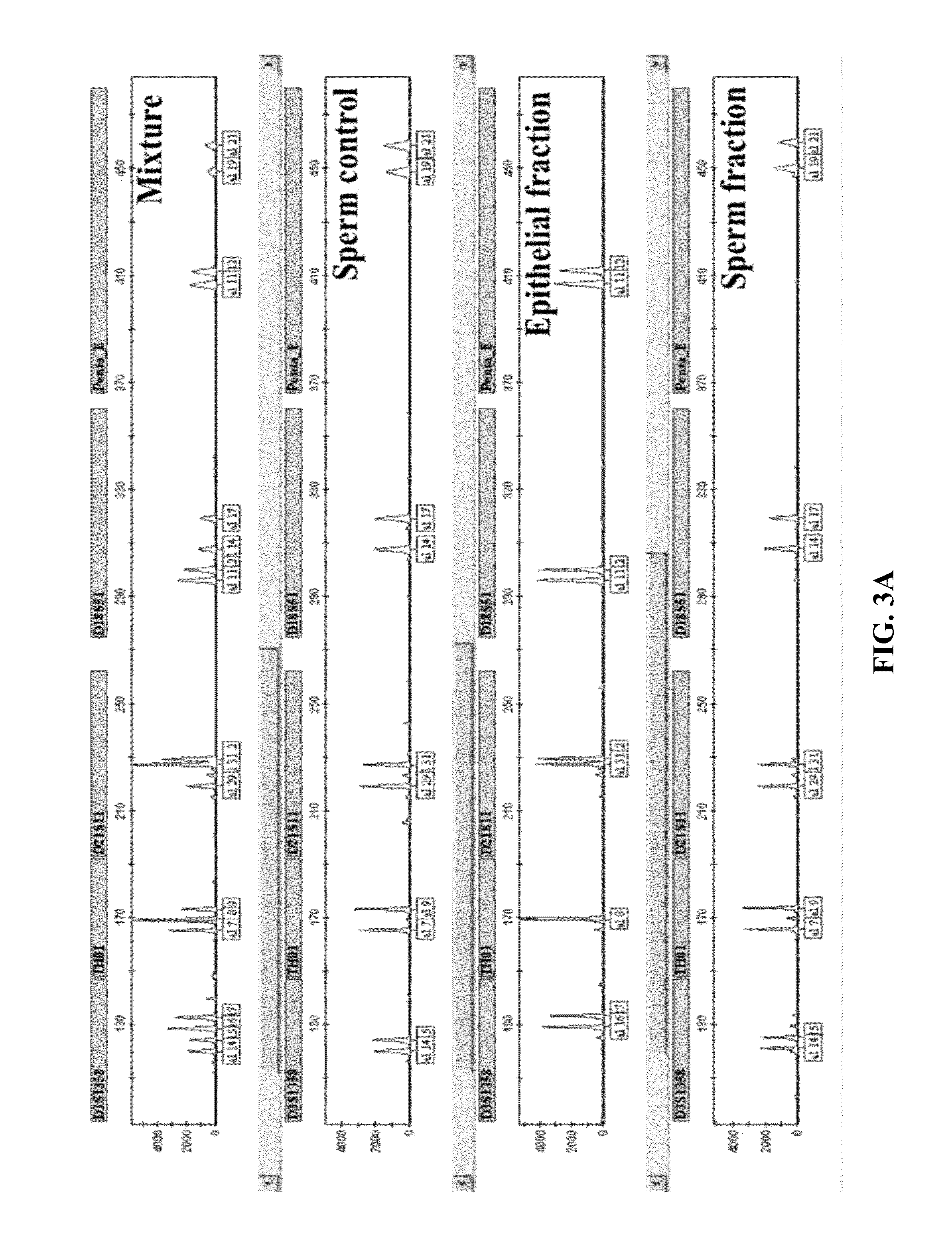Materials and Methods for Achieving Differential Lysis of Mixtures with the Aid of Alkaline Lysis and Pressure Cycling Technology (PCT)
a technology of pressure cycling and alkaline lysis, applied in the field of materials and methods for achieving differential lysis of mixtures with the aid of alkaline lysis and pressure cycling technology, can solve the problems of inability to extract sample samples from swabs, sample degradation, and inability to meet the requirements of swabs, so as to reduce the time for dna recovery and selective recovery. , the effect of improving efficiency
- Summary
- Abstract
- Description
- Claims
- Application Information
AI Technical Summary
Benefits of technology
Problems solved by technology
Method used
Image
Examples
example 1
Effect of Alkaline Lysis on DNA Recovery from Swab
[0036]The goal of the alkaline lysis studies was to determine parameters to maximize sperm DNA recovery from a cotton swab while maintaining sufficient selectivity to enable differential lysis of mixtures. The effect of varying concentrations of NaOH at different temperatures and incubation times was studied, and it was observed that incubating the swab in 0.4 N NaOH at 95° C. for 5 minutes resulted in the recovery of 2.5 times more sperm DNA than epithelial DNA (Table 1). Moreover, depending on NaOH concentration and temperature, either sperm DNA or epithelial DNA exhibited relatively higher recoveries from mixtures.
[0037]Though cotton swabs have been traditionally used to collect evidentiary material, recovery of biological samples is poor from this matrix. Many methods have been reported previously to improve cell recovery from cotton swabs [19] but they involve 2-4 hours incubation time. In cases where there are mixtures present,...
example 2
Optimization of Pct Parameters
[0039]Although the results from the alkaline lysis studies showed that 0.4 N NaOH at 95 degrees gave the best recovery and selectivity for sperm DNA from mixtures, there was still some DNA recovery from epithelial cell lysis resulting in a mixed profile. Therefore a pressure-based extraction step was introduced to completely remove epithelial cells prior to recovering the sperm DNA. In order to do this, it was important to determine the effect of pressure treatment on the recovery of epithelial DNA from swabs in the presence of 0.4 N NaOH.
[0040]Our results indicated that 104±6% recovery of epithelial cells occurred at 20,000 psi using 10 cycles of pressure in the presence of 0.4 N NaOH (FIG. 1). Furthermore, this mild pressure treatment did not have a significant impact on sperm cell lysis thus enabling the development of a two-step differential extraction protocol. Another upside of this treatment was that compared to the current extraction methods whi...
example 3
Development of a Two-Step Protocol for Differential Extraction
[0041]To achieve complete separation of both cell fractions and obtain a clean DNA profile, a two-step method was developed in which swabs were first placed in 0.4 N NaOH and exposed to pressure cycling for 5 min to remove the epithelial fraction. The cells remaining on the swab (sperm fraction) were then subjected to alkaline lysis at 95° C. for 5 min. To perform this process, the swab was first treated with 20,000 psi pressure for 10-20 cycles in the presence of 0.4 N NaOH solution. Following pressure treatment, the sample was immediately neutralized with 2 M Tris (pH 7.5) and the swab was transferred to a spin basket placed in 2.0 mL tube and centrifuged at 13,000 rpm for 5 minutes. DNA was purified with phenol-chloroform-isoamyl alcohol (25:24:1) followed by ethanol precipitation (epithelial fraction). The swab was transferred to a 1.5 mL tube containing 0.4 N NaOH solution and the sample (sperm fraction) was incubate...
PUM
| Property | Measurement | Unit |
|---|---|---|
| cyclic pressure | aaaaa | aaaaa |
| cyclic pressure | aaaaa | aaaaa |
| cyclic pressure | aaaaa | aaaaa |
Abstract
Description
Claims
Application Information
 Login to View More
Login to View More - R&D
- Intellectual Property
- Life Sciences
- Materials
- Tech Scout
- Unparalleled Data Quality
- Higher Quality Content
- 60% Fewer Hallucinations
Browse by: Latest US Patents, China's latest patents, Technical Efficacy Thesaurus, Application Domain, Technology Topic, Popular Technical Reports.
© 2025 PatSnap. All rights reserved.Legal|Privacy policy|Modern Slavery Act Transparency Statement|Sitemap|About US| Contact US: help@patsnap.com



